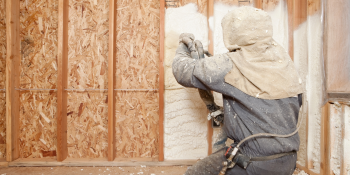Q&A Forums
spray foam to rafters question Post New Topic | Post Reply
| Author | Comments |
|---|---|
|
Randy Hampton
Posted: Feb 26, 2012 09:04 AM
|
spray foam to rafters question
Hello all, great forum. I have a 25 year old 2 story house about 2900 square feet in Macon, GA(so my question mainly deals w/summer heat vs winter cold). My air handler & all ductwork for upstairs is all contained in the attic. I've had issues with the A/C not being able to keep up in the summer time upstairs in the past. My heating & air unit is fairly new & I've had it checked out & everything was working properly. I was told that my insulation was the problem in the attic as it's the blown in kind & some roll up kind(forgive me for not knowing the correct terms) on the knee walls & it was just inadequate. I had a blower door test done last year that confirmed I needed more insulation. Anyway, I decided last summer instead of adding the traditional insulation that I would go the way of having them spray foam the rafters and the side walls to bring the attic into the "building envelope". They sprayed open cell foam. This brought my attic temperatures down from about 130 to upper 90's or low 100's, but it seemed like my a/c unit still struggled some(not as much) to keep up. My question is(because I have had a difference of opinion from local "experts") should the old insulation be removed from the attic floor to allow more air to get into the attic & cool it down some more? I assume I want to encourage this? Sorry for the long post, I just wanted to make sure I provided enough info. Thanks for your help! |
|
maurice richter
Posted: Feb 26, 2012 05:33 PM
|
Seems to me that whoever sold/installed that hvac system did not do a proper heat loss/gain calcualtion. An engineer who taught a class I took says that the wrong way is to stand at the street curb, hold your thumb up, and see how many "thumbs" wide the house is, with 1 ton = 1 thumb! Seriously, I do commercial refrigeration; my employer guarantees my work, I had better quote a system that WILL cool to regulations, not just quote the same thing that was in it that failed. The firm that did the blower door test, were they able to calculate your heat loss/gain and compare that to the "new" equipment? (I am not an SPF contractor but I am enjoying what has been sprayed in my house!) |
|
mason
Posted: Feb 26, 2012 07:30 PM
|
The insulation on the floor of the attic is not helping you if you have an unvented attic. It is keeping the attic closer to the outside temperature. Remove the insulation and see what happens. If it still cannot keep up, check out any spots they might have missed. Or, maybe they didn't put enough spray foam in place. How much did they spray? |
|
Randy Hampton
Posted: Feb 27, 2012 07:36 AM
|
Great thanks for the replies. First off, there is approximately 6" of spray foam to the rafters. The foam covers the majority of the 2x6 rafters, in some places, you can see parts of the rafters, but the majority is covered & really has expanded to about 7". It looks like there's good coverage everywhere, but I haven't checked the attic out from end to end. The guy that did the energy audit & blower door test didn't give me the actual # or % of heat loss. He was BPI certified and certified by GA Power. Part of the reason I went with spray foam was due to the multitude of things that needed to be done to properly insulate the "old fashioned way". All the knee walls needed to be redone due to poor/old batting, the pull down access door to attic needed to be changed out or insulated, I have another access door that was not insulated, blown in insulation needed to be added, I had duct work that was leaking & needed to be insulated(but not leaking terribly bad)...this is why the idea of a non-vented attic was such a good idea for me. The spray foam cost just marginally more than the additional work that needed to be done and I would have a much more comfortable attic. So, is the consensus on here that I need to remove the insulation from the attic floor? If so, is there a better way than just sucking it up and bagging it up(which doesn't sound like a lot of fun)? Or, would it be ok to remove the batting and just strategically rake it into piles where there are places w/no insulation & others w/piles of insulation(figuring that the heat would find the uninsulated places). Thanks for everyone's help! |
|
John Shockney
Posted: Feb 27, 2012 11:09 AM
|
Hi ranman, The first thing I would point out is that a blower door cannot determine or confirm that you need more insulation it can only tell you that the building or ductwork is leaking air somewhere. From there a good inspector can help you find and repair the air leaks. Personally from what you have said about the state of the old insulation I don’t think that leaving it or removing it will make any difference in the A/C performance. I would check and repair any air leaks in the ductwork having worked in Yuma, AZ as a HVAC serviceman I can tell you that with only a 20deg TD air flow is very important and you don’t need conditioned air in the attic even if it is insulated. As Mason pointed out make sure that no outside air is getting into the attic. Did they pull the fiberglass away from the eves and seal from the top of the wall/ceiling to the roof deck with foam? Also remember that 6+ inches of open cell is only R-23 and yes that is better than R-40 fiberglass it is only R-23 when doing heat loss/heat gain calculations. Also since heat loss/heat gain is from the total square footage exposed to the outside and insulating the roof increases the square footage exposed this will increase the heat gain/loss. ? what color is the roof? This will greatly affect the heat gain and cooling costs. Airpro |
|
Posted: Feb 27, 2012 11:34 AM
|
Maurice, I like the wrong way...lol. That is the first time that I ever heard that one. |
|
Randy Hampton
Posted: Feb 27, 2012 12:55 PM
|
Thanks for the response Airpro. You're right about the blower door not pinpointing exactly where the leakage may be. While it was going on, I walked around with the guy and felt around for drafts. The biggest drafts were from the openings to the attic for sure. Before I had this done, I was sure that it would have been leaking windows, which are 25 year old wooden windows, but there was no draft at all around them...boy am I glad I had the test done because I would have sunk $10k+ in windows expecting to see a difference & I likely would not have. Anyway, he also did a testing of the ductwork(I forget the name of that test). The leakage for the upstairs system was not as bad as I thought it would have been either. I forget the exact percentage, maybe 10-12%, which I thought was bad, but turns out is about average. Actually, I was told since I went with the unvented attic, I would be better off not trying to tighten this up as the "wasted air" would just help to cool the attic, which is now "inside the building envelope". As to the roof color, of course it's black. We have a lot of mature trees around the house except the late afternoon sun & I'm sure this is a problem as well... |
|
Posted: Feb 27, 2012 04:02 PM
|
The insulation on the floor HAS TO BE REMOVED. Code says that you can have only one vapor drive. Batt on the floor and foam on the roof makes 2 "vapor drives". The insulation removal is in the manufactures training books and it is even repeated so that it is understood. So, the answer is "Yes" remove it. |
|
Caleb DeFord
Posted: Feb 27, 2012 10:38 PM
|
"Sprafoaminspections" Insulation makes vapor drives huh? I thought humidity did that. -Foamilyman |
|
John Shockney
Posted: Feb 28, 2012 10:26 AM
|
First of all we are talking about a cooling problem and if there was a moisture drive issue it would be from the warm side to the cold. Do you have condensation forming on top of the cold drywall? I don’t think so!! If you want to reduce your cooling costs increase the spray foam to R-40 or replace the roof with white shingles. I had a customer in Yuma that had cooling problems with a SW room and dark exterior walls he solved the problem by painting them artic white. White paint is the best and cheapest radiant barrier insulation there is. Airpro |
|
steven argus
Posted: Feb 28, 2012 11:14 AM
|
SprayFoamInspections, Could you please explain your theory? I'm w/ airpro on this one. What training books you reading? What are you're credentials? Don't believe what Sally Stuthers says on the infomercial... |
|
steven argus
Posted: Mar 01, 2012 03:49 PM
|
Mr. Inspector must be out inspecting... |
|
Anthony Scarpelli
Posted: Oct 15, 2012 10:01 PM
|
Ranman, You need to remove the insulation from the ceiling. Unless you are selling this house within a few years, it makes sense to tighten it up as much as possible. I am remodeling my personal home and I added the vent less attic with open cell foam and did the walls as well. I also spent the extra 6 hrs of my own labor and about $80 worth of mastic duct seal to tighten up my duct work even through it is within the now conditioned attic. Point is I want that a/c going exactly where I want it. The attic will get cooled or heated from the other conditioned space not by accident so I disagree with whoever told you not to worry about the duct work. If that were true then why even measure it? With this same setup I was able to downsize my 3 ½ ton unit to 2 tons. I have a slab home with no rim joist or basement/floors to insulate. Something doesn’t sound right with your situation. Almost always heating and a/c companies over size hvac not undersize it if they are at all reputable because they do not want to get called out in July when its 100 d f outside and 80 df in your house. Poorly insulated your home probably requires 5+ tons of a/c or more. If you have a black roof and it is 2900’ of roof that is killer and could add another ton or more on top of my estimates. Here is what you can do now. You can add what is called white roof. It is a ceramic infused white paint which reflects over 88% of the sun radiant heat in the summer. I’d recommend you do it. 60% of gain/loss of heat is through the roof, 20% is through the rim joist and 20% is through the doors. This doesn’t include windows/doors of course but since you upgraded those already it is beyond the point of this thread. So I’d make sure I have a foam insulated attic as well as either the rim joist, basement or crawl space insulated and then I’d look at what is in the walls? The walls can be done by injection. If this is not an option then you can at least have some winterization done to the walls by sealing the walls. This white roof radiant paint I told you about can also be added in most colors to the southern and western walls of your exterior to help with heat gain. Since the a/c is newish I would get another contractor to come check it out and make sure it was installed correctly and sized appropriately to begin with. This does not sound right to me at all. One last option is to get a dehumidifier going to dry out the air in the house during the summer particularly. Keep it below 50% relative humidity. |
|
Mark Mouton
Posted: Oct 19, 2012 01:42 PM
|
The best way is to remove the insulation in the ceiling so you can condition the attic through the sheetrock and penetrations, but if you cut a hole in the supply plenum(say a 6 or 7")and blow air into the attic, then be sure it has a place to return back into the living area to the A/C return, you would be close to accomplishing the same thing. |
|
Christopher Gruenwald
Posted: Nov 06, 2012 04:16 AM
|
YOU ABSOLUTLY MUST REMOVE THE INSULATION FROM THE ATTIC FLOOR. Reason being, after spraying the roof deck fully with spray polyurethane foam if the old insulation is left in place your attic traps heat, hot air is capable of holding a lot of moisture. At night when this hot air finally cools it can condence causing moisture problems. Remove the insulation, your attic will then stay within 10 degrees or less of your house. When you create a unvented attic it must be a controled climate. |
|
Christopher Gruenwald
Posted: Nov 06, 2012 04:32 AM
|
No the best way to remove insulation is a large vac. Not a shop vac, this vac I'm talking about is in a completely different catagory. It can be rented. It's got a large vacuum body and is powered by an 18hp gas motor. You can get a couple hundred feet of hose if you need to. All the insulation is blown into a mesh bag which holds around 2 yards of insulation. Then you just throw it away, no mess, no shoveling, no stuffing it into bags. If you can't find one locally you can have one shipped out truck freight by calling 763-208-2266, ask for Bill Gorrilla. Tell him Chris Gruenwald sent you. Best of luck to you. |
|
David Lamb
Posted: Nov 08, 2012 08:25 AM
|
Dakota Spray Foam Insulators is correct that the old insulation must be removed to prevent potential moisture build up and to allow the cooling system to work properly. The attic was sprayed to maintain a temperature in the now conditioned space within a few degrees of the rest of the house and by leaving the old insulation between the now conditioned attic and the main house the cooling effect is drastically lessened. The cool air in the main house is slowed from traveling into your attic space by the existing insulation in your ceiling and without removing the existing insulation and adding proper HVAC ducting into the space poor performance is to be expected. |
|
mark moyer
Posted: Nov 12, 2012 07:18 AM
|
...so what if it was in there for sound deadening???cause the now wonderful conditioned space upstairs is gonna be an apartment and the slumlord sees no reason to suck it out...and it kinda makes sense,,, ...just sound batt a bunch in the last custom we sprayed,, hmm...ooooohh..and it makes me wonder... |
|
John Shockney
Posted: Nov 13, 2012 08:41 PM
|
Ok, looking back through the replies and the original problem expressed by the customer can any of you that are saying that the insulation must be removed please explain how that will reduce his cooling load and costs. I do agree that sealing the ductwork and getting the air flow to where you need it will help. But removing the insulation from the attic floor and cooling the attic more will only increase the temp difference at the roof insulation and increase the heat gain through it. The air in the attic is acting as insulation in this system, remember air is one of the best insulators there is. I think this whole thread is an example of how some contractors think that you can get energy savings by just spraying a minimum amount of foam to the underside of the roof, but what they forget is that by doing so they can actually increase the summer heat load. 1. The roof has more square footage of exposed surface. 2. The air space provided being a properly vented attic reduces the radiant heat load in direct contact with the insulation. With dark roofs this can be a very important factor. 3. If you are replacing 12 inches plus of cellulose or fiberglass with only 6 inches of open cell foam you may have an equal effective R-value but the heat load will be more and the cooling cost will not go down. My conclusion is that if you want lower cooling costs you need to spray 8-10 inches of open cell foam not 6 to achieve real energy savings. Airpro |
|
Anthony Scarpelli
Posted: Dec 09, 2012 11:48 AM
|
Dark/black roofs should only be used where there are high heating costs(heating oil/electric heat) and also where you have to heat more than six months a year such as north of Baltimore so to speak. This is why my recommendation is to paint the south, west sides and the roof with a light reflective paint. Secondly, if a proper manual J was performed and sized the a/c this could not happen unless the contractor used improper installation techniques. Thus my recommendation for another HVAC contractor to check the installation. Such things as size of unit are obvious but what is less obvious is knowledgeable or unethical contractors might use to small of a line set for the refrigerant to go between the coils and the house reducing effectiveness of the unit. Or the line may not be insulated, or partially clogged. If unusually large windows on the south or west side of the house they should have shade added to the outside such as awnings, trees or film on the glass. Finally, the only thing we know is that you have insulation in the attic. You should ensure to do the same with Rim joist or crawl space for another savings of heat gain and an old house probably has no insulation in the walls, you can have insulation blown in from the outside.....I would insulate the walls. I would never put new windows in a home for energy savings. I would fix the old wooden windows and add custom made if necessary, storm windows. One last thing, rereading this, you should ensure that the duct work is adaquate. A new built home with 1400' per floor and two floors would often have a zoned a/c system rather than one large one. They do this for two reasons, first it is cheaper to put the proper amount of cooling where you need it. DO not need it upstairs during the day normally or down stairs over night when you are in bed. Secondly because smaller a/c units are more efficient. So 2 two ton units are more energy efficient than a single 4 ton. Also with a zoned system it is ok if you slightly oversize one of the zones for those 110 D F days since both zones do not run all the time anyway. It is a no no to over size a/c so you would not want a 4.5 or 5 ton where 4 tons is required but if you had two 2 and 2.5 ton units this is acceptable. |
|
Raymon Bobbitt
Posted: Oct 31, 2015 04:38 PM
|
Hello all, I realize that this is an old thread but I wanted to see if I was way off base in my understanding of this problem. First, By insulating the rafters and the knee walls with SPF, he is either: 1) creating a hybrid attic where the space inside of the knee wall is non-vented and outside of the knee is vented or 2) insulating the knee wall is wasted money as both sides are non-vented (if the rafters are filled all the way to the eaves and the eves are sealed.) If the net effect is a hybrid attic, the the outside air will easily leak under the knee wall into the living space seriously reducing the effectiveness of the rafter insulation. If this is the case, the correct solution is to insulate the rafters down to the eaves and seal them with closed cell as there is no vapor barrier in the eaves. my .02 Thanks |





























